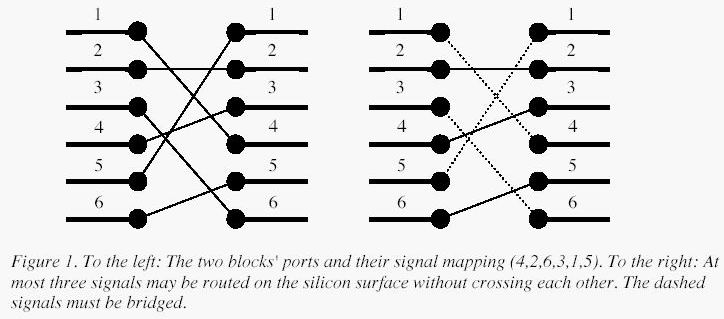Bridging signals
来源:互联网 发布:4选1数据选择器的测试 编辑:程序博客网 时间:2024/05/16 14:00
'Oh no, they've done it again', cries the chief designer at the Waferland chip factory. Once more the routing designers have screwed up completely, making the signals on the chip connecting the ports of two functional blocks cross each other all over the place. At this late stage of the process, it is too expensive to redo the routing. Instead, the engineers have to bridge the signals, using the third dimension, so that no two signals cross. However, bridging is a complicated operation, and thus it is desirable to bridge as few signals as possible. The call for a computer program that finds the maximum number of signals which may be connected on the silicon surface without crossing each other, is imminent. Bearing in mind that there may be thousands of signal ports at the boundary of a functional block, the problem asks quite a lot of the programmer. Are you up to the task?

A typical situation is schematically depicted in figure 1. The ports of the two functional blocks are numbered from 1 to p, from top to bottom. The signal mapping is described by a permutation of the numbers 1 to p in the form of a list of p unique numbers in the range 1 to p, in which the i:th number specifies which port on the right side should be connected to the i:th port on the left side.Two signals cross if and only if the straight lines connecting the two ports of each pair do.
On the first line of the input, there is a single positive integer n, telling the number of test scenarios to follow. Each test scenario begins with a line containing a single positive integer p < 40000, the number of ports on the two functional blocks. Then follow p lines, describing the signal mapping:On the i:th line is the port number of the block on the right side which should be connected to the i:th port of the block on the left side.
Output
For each test scenario, output one line containing the maximum number of signals which may be routed on the silicon surface without crossing each other.Sample Input
46
4
2
6
3
1
5
10
2
3
4
5
6
7
8
9
10
1
8
8
7
6
5
4
3
2
1
9
5
8
9
2
3
1
7
4
6
Sample Output
39
1
4
Source
Northwestern Europe 2003
思路转载自大神~~~
题目大意:两边都有N个点,给你N个点的连线关系,现在删除一些线,使剩下的线不想交,
求不相交的线最多有多少条。
思路:都知道是最长上升子序列,那么怎么来的呢
比如说现在有6对点,从上到下,左右两边的点是依次递增排序的。如果想让总的不相交的线数
最多,那么从左边第一个点开始,每个点就要尽可能和右边序号最小的点连接,这样以后的点才
能和更多的点连接。但是如果之后两个及两个以上的点所能连接的点都比第一个点连接的右边点
序号小,且不相交,则舍弃第一个,选择之后的点,否则选择前一个。
如题目中的图所示:
左1和右4相连接,之后左2和右2相连接,产生相交,右2比右4小,则舍弃左1和右4,
选择左2和右2的连接
之后左3和右6相连接,右6比右2大,不产生相交,则选择左3和右6的连接;
之后左4和右3相连接,产生相交,右3比之前右6小,则舍弃左3和右6的连接,选择左
4和右3的连接;
之后左5和右1相连接,与之前两条线都相交,右1比之前的右3小,同时也比右2小,舍
弃前两个连接选择这一个不符合最优情况,所以舍弃;
之后左6和右5连接,右5比右2大,不产生相交,则选择左6和右5的连接;
最终选择左2和右2的连接,左4和右3的连接,左6和右5的连接,满足最多不相交的情况
综上所看,所求最所不相交线的条数就是左右点连接关系的最长上升子序列。
注:此题的规模是40000,求最长上升子序列 O(N^2)的算法会超时,需要用到O(NlogN)
的算法。具体算法讲解参考博文:http://blog.csdn.net/lianai911/article/details/20554865
#include<cstdio>using namespace std;int a[40002],d[40002];int main(){ int T; scanf("%d",&T); while(T--) { int n; scanf("%d",&n); for(int i=1;i<=n;i++) scanf("%d",&a[i]); int len=1; d[1] = a[1]; for(int i=2;i<=n;i++) { if(d[len]<a[i]) { d[++len] = a[i]; continue; } int l=1,r=len,mid; while(l<=r) { mid = (l+r)/2; if(d[mid]<a[i]) l = mid+1; else r = mid-1; } d[l] = a[i]; } printf("%d\n",len); } return 0;}- Bridging signals
- Bridging signals
- Bridging signals
- Bridging signals
- Bridging signals
- Bridging signals
- Bridging Signals
- Bridging signals
- Bridging signals
- Bridging signals
- Bridging signals
- Bridging signals
- pku 1631 Bridging signals
- POJ 1631 Bridging signals
- PKU的Bridging Signals
- ZOJ 1986 Bridging Signals
- Bridging signals POJ 1631
- poj1631 Bridging signals
- Linux下编译带x264的ffmpeg的方法
- TF标准模型TensorFlow Mobile for Android
- AndroidStudio Cmake学习--如何漂亮的使用jni
- websocket原理
- codemirro 设置提示信息
- Bridging signals
- 使用Mybatis-Generator命令提示符方式自动生成Dao、Model、Mapping相关文件
- spring 定时任务
- 学习日志2017.12.08
- Spring Boot日志配置详解
- 【备忘】2017年数据分析与机器学习实战到经典案例全套高清视频教程(基于Python3.5 anaconda4.2)15G
- 使用NLTK对中文文本进行简单分析
- java学习、java教程:Java基础常见英语词汇
- Python3 初学实践案例(2)将源目录中的图片用MD5命名并可以设定目标目录


